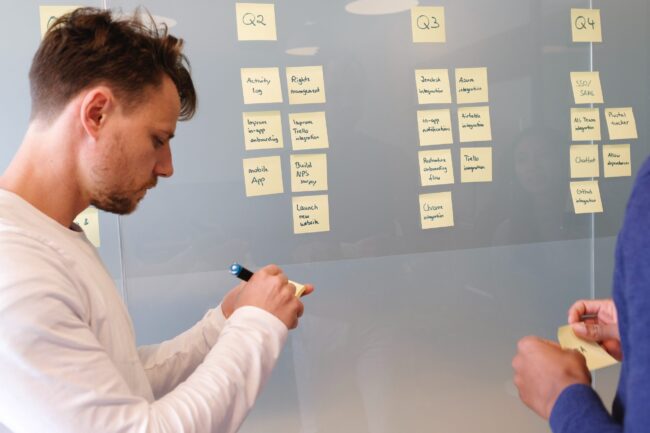Balancing work with parenting responsibilities is tough at the best of times. But with homeworking, home-schooling and changing school schedules thrown into the mix during lockdowns, life has become even more stressful for working parents with children of school or pre-school age.
According to the Modern Family Index, there were 13 million working parents in the UK in 2019. For the same year, the Office for National Statistics reported that 75.1% (three in four) of mothers and 92.6% of fathers with dependent children were in work in the UK. All these numbers have been increasing steadily over the last 20 years or so.
It’s quite likely you’ll have working parents in your team, and you may even be one yourself.
Although we’re all in this together, each of us will be experiencing lockdown from our own unique perspective. As a working Mum myself and with working parents in my team, I can empathise with others in similar situations. I wanted to use this space to share a few of my own experiences and some coping strategies to help working parents – employers and employees alike – deal with these challenging times:
1. Keep talking!
The old adage has it that sharing concerns and worries with others halves the problem, and here at Organic P&O Solutions, we concur wholeheartedly with this simple piece of advice. Many of the challenges we’re asked to help with could have been resolved earlier if people had just had a conversation and reached out for help.
Employers and employees need to engage in open and honest dialogue, so there’s a clear understanding of the support everyone needs to do their job effectively. The answers may not always be easy or immediately apparent, but in our experience, solutions usually emerge from dialogue.
And it shouldn’t just be employees that open up about the challenges they may be facing. There can be a lot of pressure on an employer to present themselves as superheroes to their team. It’s an unrealistic image, and a better approach would be to demonstrate that they are in fact human – by, for example, admitting they’re finding home-schooling tough or that their energy levels have dipped. There’s no need to go into details, but by doing this, they will be helping encourage employees to share their own issues as well as taking the pressure off them to try to be perfect employees.
2. Find ways to connect with people you need & who need you
Lockdowns and social-distancing have reminded us just how much we depend on each other for support, and it’s important we find new ways to stay connected, offer help – and accept it when it’s offered to us. Every one of us is impacted by the pandemic, and by working together, rather than in isolation, there are plenty of ways we can support one another.
Think about where you need help, and about the support those in your work or social network might need. Are there places where these needs cross over? Perhaps there are ways you can mutually support each other professionally, personally or emotionally.
From a personal perspective, although I’m good at working on my own, I do need to interact with my team. I miss the breakfast meetings we used to schedule. While face-to-face conversations over coffee and croissants are not possible, I make sure we do the next best thing and make full use of video calling – not only to discuss business but also to socialise virtually and catch up for a chat.
Outside of work, I love to run, but with home-schooling as well as working I’ve had to reschedule things. I’ve taken to running with a friend once a week when my son stays with his Dad, and I also go on a regular monthly walk with another friend. It’s a temporary routine that allows me to meet my home and work commitments, get exercise and have some invaluable social interaction.
3. Be realistic & go with the flow
For anyone working and having to look after children, these are stressful times. Being a full-time carer, teacher, Mum or Dad, and doing a job from somewhere that’s probably part-home, part-nursery, part-school and part-office; and maybe with a working partner sharing the same space, is likely to stretch anyone’s nerves, patience and energy reserves to their limits.
It’s a situation that requires putting on and taking off different hats throughout the day. As far as is possible, try to engage the right mindset for the task at hand. This is easier said than done, but where you can, try to compartmentalise your time, dedicating set periods to tasks rather than attempting to multi-task too much.
Crucially though, don’t stretch your personal limits. The combination of high stress levels and depleted energy means you need to be realistic in your expectations of yourself and own what you can realistically achieve.
Over the summer, I realised I couldn’t sustain my early morning FastTrack Fit Camp sessions on the same days that needed me to still have energy to run around with my son or go out with him for a bike ride. Something had to give, or I’d burn-out, so Fit Camp sessions had to take a break for a little while.
I do also think that trying to make some space for yourself each day is essential. Being a lark, I start work early in the morning – usually between 6 am – 7.30 am. It means I can be with my son for breakfast and allows me to have some quiet time – for me, an essential ingredient for happiness and productivity. I get to look at the moon, enjoy a good cup of coffee and plan my day before the phone begins to ring or I’m needed on the home front!
4. Recognise that positivity & negativity both have roles to play
Our nature will mean we tend to either lean slightly towards pessimism or optimism. The scale and duration of the current situation call for balance. There’s no point in taking the approach that everything is coming up roses – but at the same time, being a complete Eeyore will get you nowhere either. Positivity and negativity can both be forces for good: the first supports resilience, momentum and forward direction, while the second can be a realism check to help identify potential obstacles and blind spots.
In short, both have their place, so embrace them and try to retain a sense of balance.
5. Allow time to transition between roles
Following on from the above point, a working parent will probably need to transition through a dizzying array of roles each day, morphing from breadwinner to teacher, confidante to cook, parent to partner, team leader to cheerleader – and more besides.
In any given hour I might have a coaching session with a client, check on my son’s schooling, clean the bathroom, work on a future product idea, give guidance to a team member about a project they’re leading and take a call for HR advice.
It’s emotionally and physically exhausting, and I know that if I don’t take at least some time out between each task, I won’t take any learnings from what I’m doing.
It’s only by learning that we can improve and make things better for ourselves, but it’s impossible to learn anything while in survival mode. Allow some time to feel comfortable regularly to allow the learning to emerge, so you can prioritise what’s useful.
6. Know your early warning signs & share them with others
If you’re struggling, it’s all too easy to just carry on and ignore the signals indicating that something is likely to give. Left unchecked work and family relationships might suffer, and mental or physical illness could become a real possibility.
It’s important to recognise as early as possible when things might be reaching a critical point, and often, others will see this in you before you see it in yourself.
Stress affects people in different ways. An out of character short temper, limited attention span, forgetfulness and excessive tiredness can all indicate that help might be needed. Most of us know how we react to stress, and we need to share our ‘tells’ with colleagues so they can look out for warning signs.
Can We Help You & Your Team Get Through Lockdown?
Hopefully, lockdowns and home-schooling will soon be consigned to history. In the meanwhile, if you or anyone in your team is struggling with the challenges of working through the current situation, Organic P&O Solutions can offer advice and support.
Get in touch with us today.









